I’ve written about this before, but since there’s a new hiking season coming on and people are still using GPS to figure out where they are I figured I’d do another piece on how to get yourself out of trouble in case you find yourself lost.
“Hey Jarhead! That would never happen to me! I carry a GPS.”
Well good for you! But that doesn’t give you permission to turn your brain off. Check out the stories here of people who turned their lives over to a GPS.
In other posts I’ve talked about how much I like the GPS on my phone. It’s awesome. I can just dial up Google Maps or whatever and figure out where I am within a pretty close radius. Usually. There have been times when I’ve checked the GPS in the woods only to discover it thought I was somewhere 20 miles away from my true location. In those cases I just put it away and went back to the map and compass.
But just because you’re carrying a map and compass or GPS doesn’t mean you won’t get lost. Even the best navigators make mistakes out there and will occasionally find themselves somewhere they didn’t expect to be. There have been several occasions when I’ve hit an obstacle – a river for example – that wasn’t on the map. There’s a sudden thrill of fear and your mind goes “Uh oh!” and for some reason you want to run. Your brain tells you to run up ahead and maybe you’ll see the trail. Maybe you will, but most likely you won’t.
Let’s say you’ve just discovered you’re lost. Your heart is racing, you’re breathing hard, and you’re mind is telling you to run. You’re way the hell out in the woods and you’ve gone off the trail and all you have is your day hiking kit with you. What do you do?
STOP! Stop. Think. Observe. Plan.
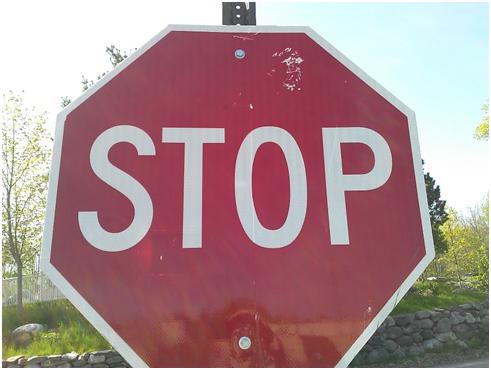
STOP! – Instead of running off and getting even more lost sit down on the nearest stump and take a deep breath. Ok, you might be lost, but you’ve got resources. Running is only going to make this situation worse. Sit there until your breathing is under control.
Think. You’ve got your daypack with you. (Right?) How can you leverage it in your situation? (Read this to see what you should have with you.) Do you have a map and compass? When was the last time you remember seeing a trail blaze or know for sure you were on the path? Were there any identifiers you can think of to get back on the trail? What can you hear? See? Where was the sun when you hiking? According to the map, which direction is the trail running? Is there running water nearby? Starting to think things through will help ease the panic.
Observe. You’ve already started doing this in the thinking step. This is important because it may or may not help you get back on track. Look for terrain features. Can you see a mountain peak or are you near a river or lake? Can you hear traffic? Which direction is north? Which way were you hiking?
Plan. Now that you’ve calmed down and assessed your situation you might discover that you truly are lost. That sucks, but hey! You’re dealing with it with a calm mind instead of running in circles flapping your arms and squawking like a chicken. You’re heading in the right direction to survive.
Leverage Your Resources
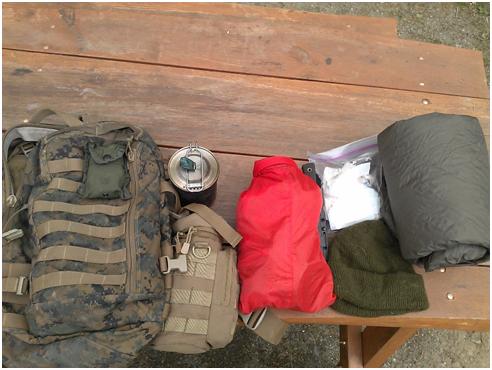
Assume you’ve taken my advice with 10 Items You Should Have In Your Pack. You now have an excellent list of resources at your disposal for a survival situation. I won’t go into detail in this article because it’s laid out in the hyperlinked post. It’s a great starting place for those of you who might not have the experience and knowledge about what to put into your own kit. You’ll find as you gain experience that you’ll come up with your own additions or substitutions. For example, you might decide to use a poncho and poncho liner instead of a wool blanket. See a discussion about that here.
Here’s the thing, if you have a map and compass and the knowledge on how to read them then you’re not really lost. You might be a little displaced for awhile, but you’re not really lost. If you look at your map you should have an idea of where you are within a couple of square miles. All you have to do is look for a hand rail such as a river or road. Let’s say you look at the map and you know you went off the trail somewhere near the middle of the map. In the grand scheme of things it doesn’t really matter. Look at the last known position on the map and then look for a river or road like I mentioned above. It will be in a certain direction from where you are. You might see a road fifteen miles east of where you are.
Follow your compass east and eventually you will find the road. It might suck walking off trail through the woods (it would here in Maine I’ll tell ya), but you will find your way out. How do I know? Because I’ve used this exact technique. I’ve felt the cold finger of panic run up my spine when I discovered I was lost snowshoeing in the woods during a snowstorm. I’ve fought down the urge to run to see what’s ahead. I’ve forced myself to sit on a log and dig out my thermos and look around with a rational eye. This isn’t conjecture on my part. These things really work.
Here’s the list:
- A canteen and canteen cup
- A lightweight rain suit
- Lighter or some other kind of firestarter.
- Survival knife
- Food – energy bars, GORP, or other kind of food that doesn’t need much preparation is a good idea; however, if you have a heat source such as a camp fire then freeze dried foods, Ramen Noodles, or any other kind of light-weight hiking food is an excellent choice. If I’m on a long hike I’ll have oatmeal and an energy bar for breakfast (don’t forget the coffee), an energy bar for a quick lunch so I can keep moving, and for dinner I’ll break out a freeze dried meal and live it up. As a side note make sure you’re drinking a lot of water while you’re moving.
- Map and Compass (I’m counting this as one unit) or a GPS. I use a Cammanga Military Compass for accuracy.
- First aid kit
- Flash light or head lamp
- Wool blanket – this item has many uses and if it gets wet it still has insulating value. You can lay it out to picnic on, wear it as a cape or shawl with a hood at night around the fire – it won’t burn like cotton or some of the synthetics out there if a coal lands on it, or you can wrap up in it case you get stuck out over night. I’ll write a full post on wool blankets later.
- Contractor bag – these have many many uses. You can stuff it with leaves or pine needles and sleep on it, which creates a comfortable bed and vapor barrier. It can be used to carry water. Some people say to use a condom, but they’re so fragile I’d be scared to death it would break and lose all my water. A contractor bag is tough and you could carry a lot of water if you needed to. (And were strong enough.) It can be used as a rain coat. It can be stretched out and used as part of a shelter to keep the rain off. It can divert rainwater into your canteen. These bags have many different uses and I suggest you get one for your pack if you don’t already have one in there.
Make a Decision – to move or not to move? If lost, most times you should stay where you are until help finds you. If you’re hurt you may not have a choice about staying where you are. In that scenario do what you can to patch or splint yourself up and get your body stable. If you decide to stay use the Rule of 3’s to guide your efforts.
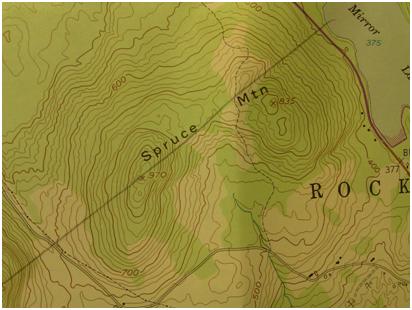
This is simply a mnemonic for helping to remember the survival sequence:
- You can live three minutes without air.
- You can survive three hours without shelter in bad weather.
- You can survive three days without water.
- You can live three weeks without food.
- You can live three months without human contact.
(This is very generalized of course.)
Using these rules as a guide line you would want to build a shelter of some kind first, then look for water, and finally concentrate on finding food. Using the kit above you could make a shelter by making a lean-to out of the contractor bag and a few well cut logs.
Now let’s say you’ve violated the rule about not telling anybody where you’re going. I’ve read many incidents where someone went on a hike, snowmobile trip, or whatever, then changed the plan or didn’t tell anybody where they were going at all. In this situation you might want to think about trying to find your way home. The danger, of course, is that you get even more lost or sustain an injury wandering around in the back woods.
Once you’ve made the decision to start moving make sure you leave plenty of time in the afternoon to make a shelter and get enough fire wood for a good fire. A fire is a wonderful tool for cheering you up, warming you up, boiling water for drinking, cooking food, and providing light. By the time it gets dark you should be all settled in with plenty of wood and a good shelter.
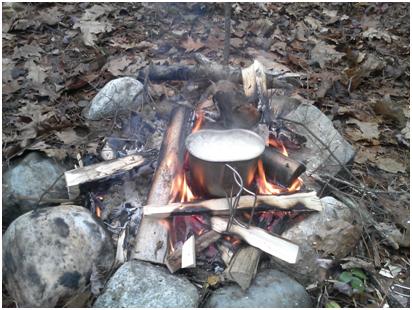
Keep your compass handy and consult it often as you move. It won’t take long moving through the deep woods to start to drift off course. Sometimes you can’t help it due to terrain features and geography, but try to stay on track as much as possible. If you didn’t bring a compass I hope you know how to find the North Star! What about finding direction during the day without a compass? Here’s how to tell direction using your watch and the sun.
Signaling
If you’re lost a major component of getting found will be finding a way to make a signal. If lost or in need of assistance try to group your signals in threes if possible. Three signal fires, three blasts from a whistle, three flashes from a mirror etc. This will show people you are in trouble.
You can also yell, wave your arms, or do pretty much anything that will attract attention. My experience has been that cell phone reception has been spotty at best and non-existent when I really needed it. Don’t rely on your cell phone as your sole means of rescue or you might find yourself disappointed. I broke my ankle on the 100 Mile Wilderness in Northern Maine once and there was zero cell reception.
By all means ff you’re in an area that has cell reception, use that phone! Call someone to come get you. I’ve heard of people calling forest rangers from the top of Katahdin to come get them because they were tired. I would advise against this as it tends to annoy the rangers.
There are many ways to signal that you’re in trouble. Check out this short video for making a few.
Be Self Sufficient
If you’re lost you need to be a MacGyver when it comes to using whatever you have for gear. Find new ways to use things. Don’t throw anything away as you might be able to use that item for something later on.
Don’t be afraid to spend the night in the woods. If you’ve never slept alone in the woods it can be kind of a freaky experience at first, but after awhile you take it for granted. These days I enjoy a night in the woods by myself, especially in a lean-to or UTS (Under The Stars), where I can hear and sometimes see what’s going on. (Not much usually.)
Don’t depend on someone coming to rescue you if you can help it. Even if you’ve decided to stay put there are always things you can be doing to make your situation better. Add to your shelter to make it even more water proof, keep gathering and processing wood, set up more signals, make figure four traps, purify water, and on and on.
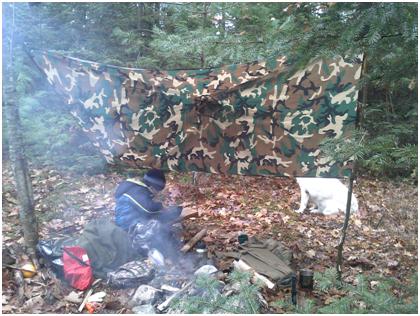
Never Give Up
No matter what happens out there, never give up. You might be scared, hungry, tired, injured, thirsty, whatever. Just remember that what you need to survive could be right around the next corner. You just have to be able to recognize it when you see it. The only time it won’t matter anymore is when you’re dead. Up until that point keep fighting.
Questions? Comments?
Sound off below!

22 comments
Fine advice Jarhead. My only addition to the daypack is a small flask of a fine bourbon…great for star watching and dreaming the fire.
Also recommend to all who have young “house-apes” to get them out early for overnight “survivor-guy” training where we only take a few items to learn to rough it if something hit the fan. Nothing like “see one-do one- teach one” experience.
Please allow me to add my two cents! 1) To your canteen and canteen cup I would add a canteen cup stove like a folding esbit stove or a slide-on style stove that carries around the cup and takes up no additional space; about 2 ounces, and allows you to concentrate your fuel (wood, hexamine tabs, alcohol, etc.) on the cup itself (waste not, want not). A spare canteen doesn’t hurt either, water is a high priority! Safety note: clear away the debris from around your campfire (see your photo above) to reduce the chance of a unwanted forest fire! 2) I find a poncho much more versatile than a rain suit! 3) Please carry several lighters as these are the best (IMHO) fire starters for ease and reliability but they can break, get lost, etc.; two is one, etc. 4) A tarp, though heavier than a contractors bag, is much more durable and versatile, I prefer a canvas one instead of plastic! 5) A spare knife or hobo’s tool is a good ideal; hard to eat soup with a knife! 6) Good article and Great Web site, thank you very much! Good Luck!
Thank you Jarhead for this article. That is a nice kit. For my area, I’d add a hammock because sleeping on the ground is not a pleasant experience where I live.
Under THINK at top, use your hearing for clues on where the road is. Close your eyes for a minute and listen for road noise, maybe the sound of a jet engine from a passing airplane (are there predominant lanes of travel in your area? If so, you should learn them, ours are mainly north / south for example).
It is so true that as soon as you think you are turned around, or lost, your mind goes into flight mode. Your advice to stop and assess is the most important step in enjoying your survival situation.
Jarhead
Damn good call on the contractor trash bags. They saved my ass. Got lost/broke down on quads many years ago. Cool overcast turned I to sleet / rain / snow. Weather wouldn’t let us make a fire. Ended up turning the trash bags into ponchos. Worked very well kept us much drier than with out.
We cut the seam on the bottom of the bag just large enough to slide over our heads. Used button rocks on the end of the cut to keep it from running and exposing our shoulders. Worked well less a hood.
One of these days I’m going to work on turning a trash bag into a poncho w hood. I guess one could put the bag over your body and juts cut out a section for your face? Anyone have thoughts on a trash bag poncho with a hood?
Great article enjoy your site.
what I would try: cut a “face hole” in the side of a bag, by a corner, several inches up from the bottom seam.
(make sure it isn’t a white trash bag, unless you want to look like ” klan” .
Hey Wally – my little ones go out in the woods with me regularly, but we haven’t done an overnight out there yet. Plenty of camping in the camper, but not in a tent or lean-to as of yet, but it’s coming!
Good post – sound advice! The local Search and Rescue team wouldn’t have much to do if everyone read and followed the advice in your story.
I go with a tarp and a contractor bag for shelter. The contractor bag is particularly useful if you’re hunting and need a clean place to stack meat.
Never carry one of those cheap mylar blankets!
Along with the tarp, though, you need to know before hand how to set up a shelter: https://www.survivalcommonsense.com/video-the-a-frame-tarp-shelter-simple-lightweight-and-effectivefeed/
Thanks Leon. Agree about the cheap mylar “blanket.”
Good link, too.
there is just no valid reason to wander out in the woods without this stuff.
does any one of us still care about: “what will people think?”
(… well maybe I do, but I shouldn’t die because of it)
it is exceedingly difficult to boil water in a condom, and only slightly easier in birch bark. (I would add a big piece of aluminum foil to the pocket kit, however)
hopefully, most of us have a vague idea of where we are, so as to pick a “bailout” direction. (much easier with a compass direction to follow)
“self rescue” is what we’re always taught to avoid, but sometimes YOU, (and the DEITY) are all you’ve got.
(don’t, in your pride, refuse to pray)
it wouldn’t hurt to leave some “trail signs” if someone (friendly) may be looking for you.
(otherwise, some situations may actually call for: “leave no trace”. easier said than done)
Hi Roger – good additions to the list. Obviously you’ve been around long enough to set up a good kit of your own. The one I present here is simply a “starter kit” for people who haven’t done it before.
About the fire – it had been raining that day, which is why I didn’t worry about clearing away the leaves. On a dry day though it’s a must in order to prevent a forest fire. Good eye!
Great catch on the listen for traffic j.r.
There have been occasions I’ll be walking along thinking I’m nowhere near a road only to have a truck blast by fifty meters away. That’s a wake up call!
True story – when I was a teenager, we were visiting a wildlife refuge (Santa Ana – Alamo Texas) which is approximately 1000 acres of dense south Texas brush which has walking paths routed through it. I had been there several times and thought that going ‘cross country’ would be kinda cool. So I took off and in less than 10 minutes, I was completely turned around. I was twisting and turning so many times, I didn’t know where I was.
I was in no danger and knew there were various walking paths on the property – I just didn’t know where they were. I was trying to remember the best possiblity of finding the path and that was when I heard voices of some hikers walking by. I was able to locate their general location and just walked toward it, waiting for them to go by (I was really embarassed, lol).
Nothing scary, just showed me how quickly you can find yourself turned around.
Thanks for sharing that, Steve. I think anybody who spends a lot of time in the great outdoors is eventually going to run into a situation where they get in trouble of some kind or other. Glad to see you had the smarts to get out of it ok.
When I found out I’d been traveling in a big circle my mind refused to accept it. I literally stood there for a 30 seconds looking at the snow tracks thinking, “Man, I can’t believe someone else is out here in this desolate part of the woods with a set of bear paws just like me. Wonder where they came in from?” When I finally figured it I had walked in a big circle I nearly flipped out.
That’s when I sat down on the log, got my thermos of coffee out, and forced myself to think clearly. I had a good kit and a compass, but since I almost never get lost I hadn’t been using it. After that little wake up call it was wrapped around my neck like a neck tie!
Agreed, Irish. But I’ve been hiking many times in all seasons and seen people completely lost with no gear whatsoever, except maybe a water bottle and a power bar. Crazy!
I went out for a walk once with “none of the above” also, and got back nearly dehydrated, chafed, and blistered.
(and there was nobody I could call for a ride)
hey I’ll never be totally useless as long as I can serve as a bad example…
When a rescue plane spots you they are not going to land and pick you up. They are going to fly low in the direction you should travel.
Late in posting but I would suggest everyone find an orienteering event in your area and go. Bring the kids, too. They are fun events that bolster your navigation skills. They have courses for all levels.
GPS in the mountains is almost worthless due to heavy tree cover and mountain ridges. I have a friend who borrowed my Garmin on our Elk hunt and proceeded to get lost twice. He said he could not get signal. I had to go find him in the dark twice. The 2 way radio was key to finding him by the descriptions of his surroundings. The first time he said he was in a bog. I new where the only bog was so off I went on the night time rescue.
Come on JS, We know you better then you give us credit for. 20 miles off course!!! That’s next county territory. You may get sloppy once in a while — we all do — but that’s just plain ridiculous. Bet you weren’t more than a couple of clicks off target.
Daniel Boone disappeared into the wilderness for several days and when he finally showed up they asked him if he had been lost. His answer was, “Nope, never lost. Just a tad confused.”
Great article! Thanks.
P.S. Don’t forget the Para cord. A dozen uses in the bush and takes little space.